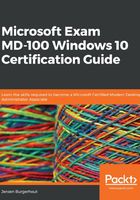
Troubleshooting networking issues
You will have to troubleshoot networking issues in Windows 10 every now and then.
Windows 10 comes with several tools that you can use to diagnose network issues. The tools you can use are as follows:
- Event Viewer: Event logs are files that document significant events, such as when a process experiences an error on a computer. In the system log, IP conflicts are reflected and may prevent services from starting. When these events occur, Windows must record the incident in a log.
To read the file, you can use Event Viewer. When you troubleshoot issues on Windows 10, you can view the events in the event logs to determine the cause of the problem. You can use Event Viewer to view the Application, Security, Setup, and System logs, which you can find under the Windows Logs node.
When selecting a log and then selecting an event, the details of the specified event are given in a preview pane under the event list. Check for errors or alerts relating to the network services in the System log to help diagnose network problems, as in the following screenshot:

Figure 8.16 - The Event Viewer window
- Windows Network Diagnostics: The Diagnose Connection Problems option helps to diagnose and repair a problem if you have a Windows 10 networking issue. Windows Network Diagnostics presents a possible description of the problem and a viable solution. The solution could require the user to intervene manually. You can open the Windows Network Diagnostics page via the Network & Internet page in the Settings app:

Figure 8.17 - The Windows Network Diagnostics page
- ipconfig: The ipconfig command shows the current configuration of a Transmission Control Protocol/Internet Protocol (TCP/IP) network. You can also use ipconfig to allow the DHCP and DNS settings to update. You may need to flush the DNS cache, as shown in the following screenshot:

Figure 8.18 - The available command-line switches for the ipconfig command
- ping: To check the connection to another TCP/IP device at the IP level, you can use the ping command. This command sends and receives echo question messages from the ICMP and shows the receipt of the corresponding echo response messages.
Important Note
Firewalls may block ICMP requests. As a result, you may receive false negatives when using ping as a troubleshooting tool.
ping is the first TCP/IP command that you use for troubleshooting communication, as shown in the following screenshot:

Figure 8.19 - The available command-line switches for the ping command
- tracert: The tracert command determines the route taken by sending ICMP echo requests to a destination computer. The displayed path is a list of the interfaces between a source and a destination router. This method also calculates which router failed and what the speed or latency is. If the router is busy, these results might not be reliable because the router assigns a low priority to the packets, as shown in the following screenshot:

Figure 8.20 - The available command-line switches for the tracert command
- nslookup: The nslookup command displays information that the DNS network can be evaluated against, as shown in the following screenshot. Apart from the presence of the necessary records, you can use the tool to confirm the connection to the DNS server:

Figure 8.21 - The available command-line switches for the nslookup command
- pathping: The pathping command traces a path through the network in a similar manner to the tracert method. However, pathping offers more detailed statistics through a network about the individual steps or hops taken. The command, as shown in the following screenshot, provides more detail because it sends 100 packets for each router, allowing it to set trends:

Figure 8.22 - The available command-line switches for the pathping command
- PowerShell: Configuring network connection settings can be achieved using Windows PowerShell. You can also use Windows PowerShell cmdlets to troubleshoot network configurations:

Figure 8.23 - The Windows PowerShell window
In this section, you learned about the possible tools to track networking issues in Windows 10. As you can see, there are many options to do this, but each command has its own command-line switches. It is advised that you carry out some practice tests because some command-line switchers will be on the exam.